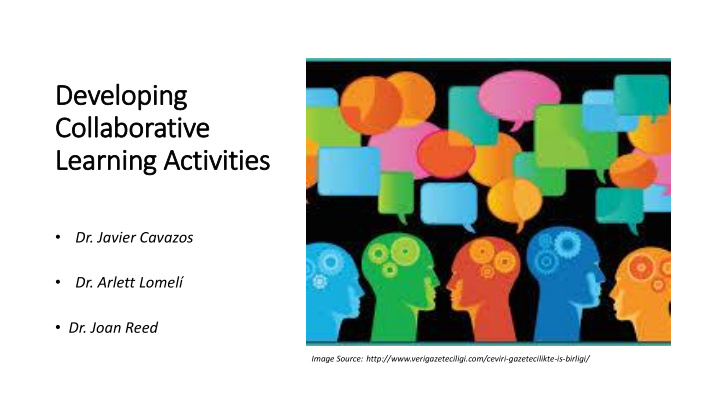



Developing Coll llaborative Learning Activ ivities • Dr. Javier Cavazos • Dr. Arlett Lomelí • Dr. Joan Reed Image Source: http://www.verigazeteciligi.com/ceviri-gazetecilikte-is-birligi/
Background Knowledge Probe • Turn to your neighbor. • Ask him or her: • What prior experiences have you had with collaborative learning?
What is Collaborative Learning? • Collaborative learning is used as an umbrella term for a variety of approaches: • Involve joint intellectual effort by students or students & teachers, • Engage individuals in interdependent learning activities. Source: Smith, B. L., & MacGregor, J. T. (1992). "What Is Collaborative Learning?". National Center on Postsecondary Teaching, Learning, and Assessment at Pennsylvania State University
Examples of Collaborative Learning • Cooperative Learning • David & Roger Johnson • Spencer Keegan • Jigsaw Process • Eliot Aronson • Team-Based Learning • Larry Michaelsen
What Research Supports Collaborative Learning? Findings of a meta-analysis comparing small-group work to individual work in K-12 and college classrooms: • Students working in small groups achieved significantly more than students working individually, • Optimal groups for learning tended to be three- to four-member teams, • Lower-ability students work best in mixed groups, • Medium-ability students do best in homogeneous groups, • Higher-ability students: group ability levels made no difference. • Some research indicates that, in university classrooms with collaborative teams, the lowest performing team outperforms the highest performing individual students. Source: Lou, Y., Others. (1996)."Within-Class Grouping: A Meta-Analysis". Review of Educational Research. 66(4), 423-58.
What are the Essential Elements of Cooperative Learning Groups? Positive Individual Group Interdependence Accountability Processing Face-to-Face Social Skills Promotive Interaction
What are the Essential Elements of Cooperative Learning Groups? Positive Individual Group Interdependence Accountability Processing Face-to-Face Social Skills Promotive Interaction
How Do I Create Positive Interdependence? Examples: 1. Goal Interdependence (essential) 2. Celebration/Reward Interdependence 3. Resource Interdependence 4. Role Interdependence 5. Task Interdependence
How Do I Create Individual Accountability? Examples: 1. Randomly call on students. 2. Have students use group work to do an individual task afterward. 3. For anything but the briefest interactions, purposefully create heterogeneous groups (students shouldn’t create their own groups). 4. Keep group sizes small…
Formal and In Informal Cooperative Groups FORMAL cooperative learning INFORMAL cooperative learning • Ad-Hoc groups last from a few • Groups last from one class to minutes to a full class period. several weeks. • Used in various ways: • Assignments are highly • 1. Focus/refocus students’ structured in advance. attention, • Students are actively involved in • 2. Set expectations about the material to be learned, organizing, explaining, • 3. Ensure that students summarizing, and integrating cognitively process the material the material. • 4. Provide closure to a lesson.
What's an EXAMPLE of Formal Cooperative Learning? • The Jigsaw Process • Developed by social psychologist, Eliot Aronson. • Develops deeper levels of learning. • A structured 3-stage process: 1. Teaching/Learning groups, 2. Expert groups, 3. Teaching/Learning groups.
How Can I Use Informal Cooperative Learning? • Create social connection FIRST… • Makes the work more productive, • Builds social connection to the classroom. • Provide explicit INSTRUCTIONS for social connection. • Example: “Turn to face your neighbor and introduce yourself.” • Even BRIEF interactions are useful. • They rejuvenate energy levels in the classroom. • Direct students’ attention to the material being learned.
DIY Informal Cooperative Learning 5 Simple Steps for Creating Your Own Informal Cooperative Learning Activity 1. Set your GOAL for learning. 2. Give a SOCIAL CONNECTION PROMPT. 3. Give CLEAR INSTRUCTIONS with a TIME LIMIT. 4. Allow DISCUSSION & WORK TIME (countdown clock for large classes). 5. Build in ACCOUNTABILITY & REPORTING.
• Turn to your neighbor… • Ask him/her… • Compare notes. Look for similarities & differences. • Create a third idea that builds on the best of each individual idea. Think – Pair – Share An Example of INFORMAL cooperative learning
Collaborative Learning Technique: Peer Editing • SLOs • Individual and group accountability • Promotive interaction • Positive interdependence • Group processing
Collaborative Technique: Peer Editing • Peer review form • Peer-edited form and response in final submission • Grading (75% individual; 25% group)
Peer Response Form
Collaborative Learning Technique: Dialogue Journals • SLOs • Individual and group accountability • Promotive interaction • Positive interdependence • Group processing
Collaborative Learning Technique: Dialogue Journals • Content • Process • Attitudes
How do we move groups to an online setting?
Semester Week Assignment: Group (GA) or Individual (IA) 1-3 IA1: Introductions 4-5 GA1: Building Structure and Culture 5-6 Preparing for GA2 7-9 GA2 10 IA2 How do I plan assignments 11-13 GA3 during the semester? 14 IA3
Individual Assignment 1: Include: Introduction Discussion Board 1. Student's goal for the course Assignment 2. Favorite TV show and Why 3. Place following items in importance: Economy, Environment, and Family. 4. What 3 rules help make a team successful? 5. What type of leadership style do you expect in the group? Responses to Classmates: 1. Something positive you liked about what their answers. 2. Explain to them what makes you and the other person a good fit for building up the team and reaching your goals together.
How do we get everyone to work together? Group Enrollment and Group Wiki Pages
Helpful Tips: 1. Wiki Pages 2- ∞ : Create Column within Full Grade Center 2. Create more groups than needed 3. Group Problem: What did they agree to resolve these situations? 4. Blackboard IM group chat 5. Provide unlimited submission attempts on assignments
Final Reflection and Application Activity • Turn to your neighbor. • Ask him or her: • What did you learn today? How will you apply what you learned to your teaching? How will you learn more about collaborative learning in the future?
Questions? • Dr. Joan Reed • Dr. Javier Cavazos • Dr. Arlett Lomelí
Recommend
More recommend